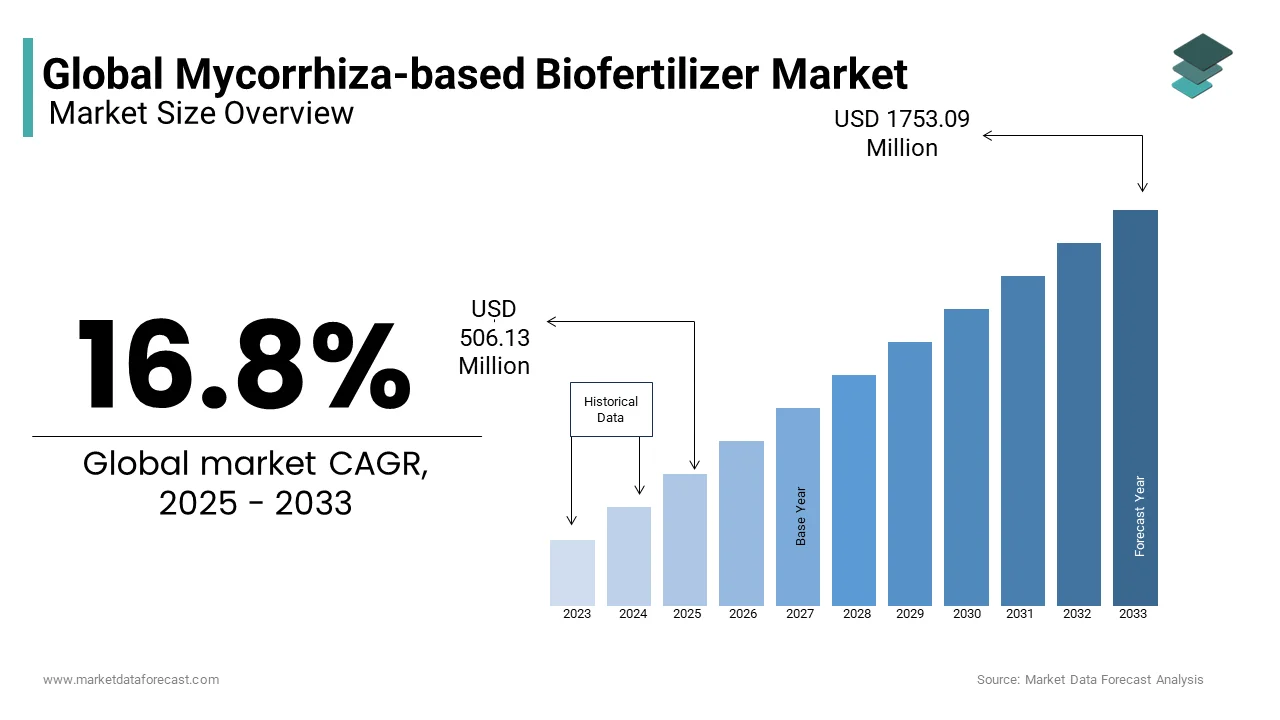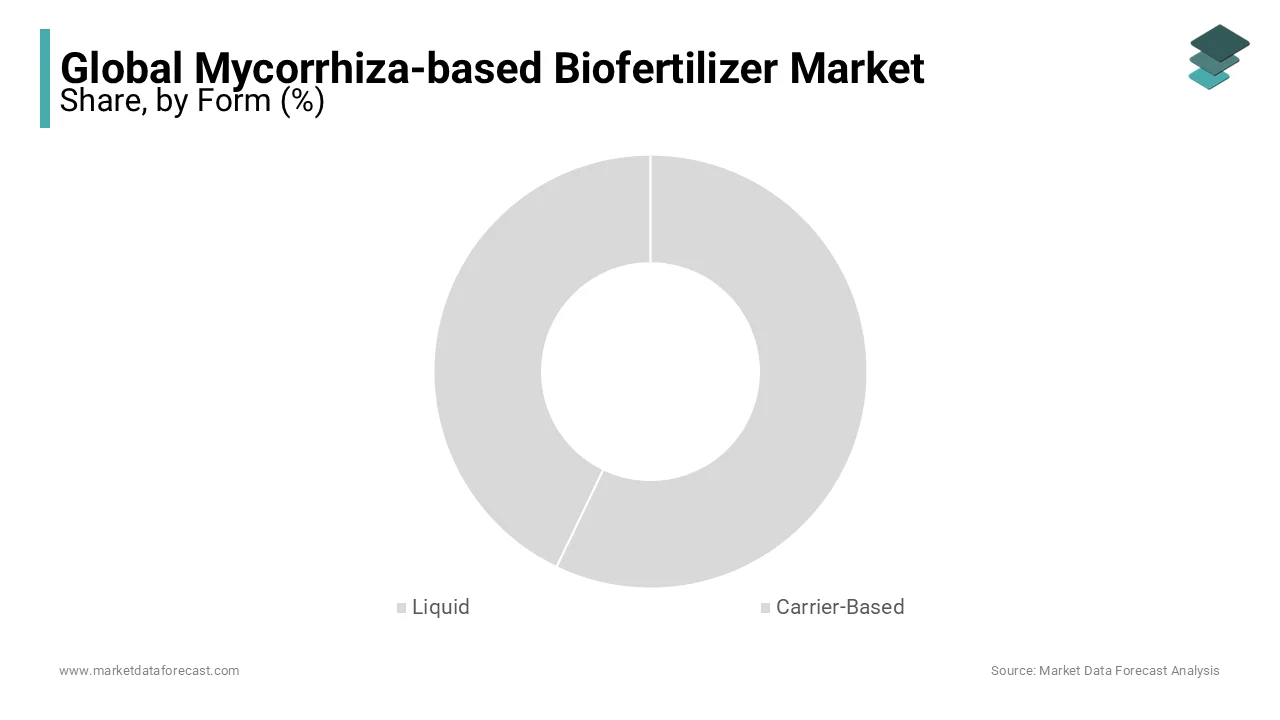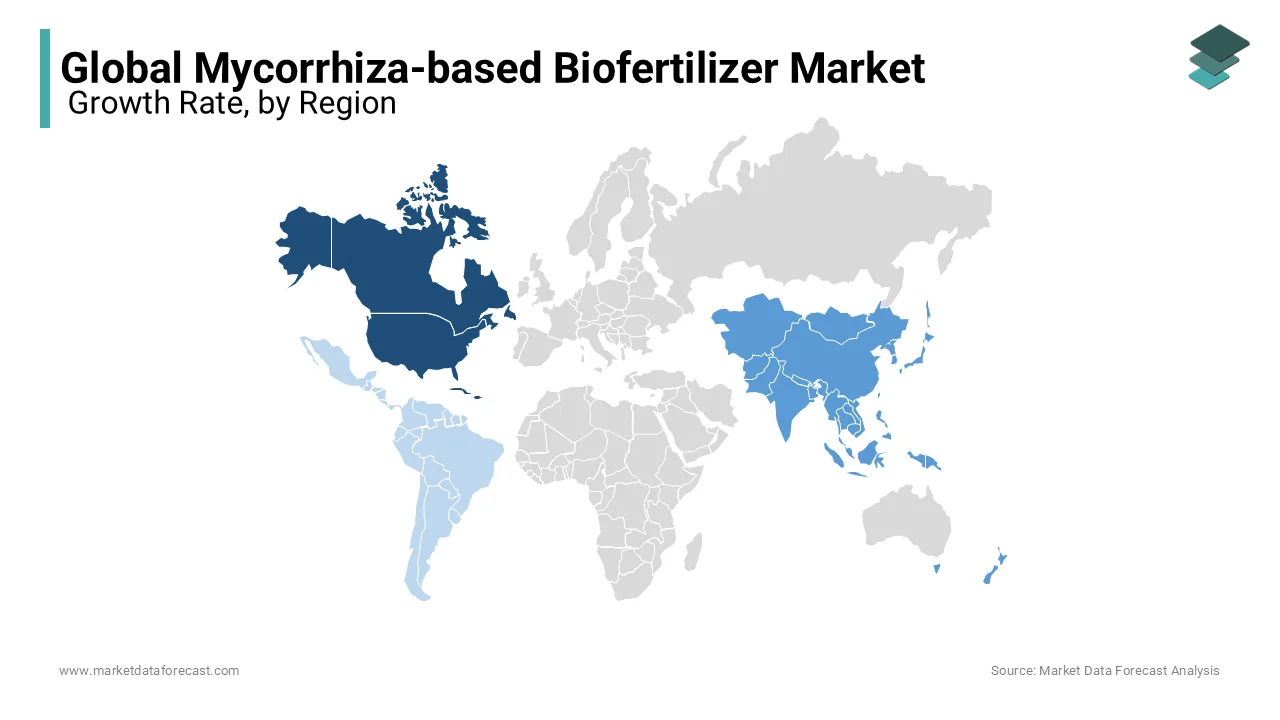Global Mycorrhiza-based Biofertilizer Market Size, Share, Trends & Growth Forecast Report Segmented By Form (Liquid & Carrier-Based), Mode of Application (Soil Treatment & Seed Treatment), Crop Type (Cereals and grains, Pulses and oilseeds, fruits and vegetables, Others) & Region (North America, Europe, Aisa-Pacific, Latin America, Middle East And Africa), Industry Analysis From 2025 to 2033
Global Mycorrhiza-based Biofertilizer Market Size
The global mycorrhiza-based biofertilizer market was valued at USD 433.33 million in 2024 and is anticipated to reach USD 506.13 million in 2025 from USD 1753.09 million by 2033, growing at a CAGR of 16.8% from 2025 to 2033.

The global mycorrhiza-based biofertilizer plants in which this association is observed are corn, carrots, leeks, potatoes, beans, soybeans, other legumes, tomatoes, peppers, onions, garlic, sunflower, strawberries, citrus fruits, apples, peaches, grapes, cotton, coffee, tea, cocoa, sugar cane, forest species, wild plants, and even weeds. Mycorrhizae are fungi that live in the roots and soil of higher plants. They form an association with the roots of plants in a non-host-specific way. Mycorrhizae is a fungus that establishes a symbiotic association between a fungus and the roots of an avascular host plant. Mycorrhizae is a symbiotic and mutualistic relationship between soil fungi and plant roots.
Mycorrhiza-based biofertilizer promotes plant growth by enhancing nutrient acquisition and promoting growth hormones. They also increase the resistance in plants against plant pathogens and the surface area of the root system for better absorption of nutrients from the soil. The favorable policies put in place by the government for organic farming are increasing the growth of the global Mycorrhiza-based biofertilizers market. Many governments in developing countries such as India, China, Indonesia, Brazil, etc. encourage the use of Mycorrhiza-based biofertilizers. Recent initiatives by various regional bodies in the establishment of microbial research institutes are stimulating their growth. Mycorrhiza-based biofertilizers are mainly used for their symbiotic nitrogen-fixation capacity which helps to increase nitrogen levels in the soil.
MARKET DRIVERS
The rapidly growing organic market is driving the growth in this market. The organic food market is growing at a rapid rate, which is creating a high demand for Mycorrhiza-based biofertilizers. This increased consumer awareness of growing health risks and increasing levels of residues in food and other environmental issues has led consumers to prefer food products without chemicals. Biofertilizers and organic fertilizers are in high demand due to the rise of the organic food sector, as they are required for organic farming. The market is driven by increasing food demand and the need for sustainable agricultural development, as well as the remarkable efficacy of using mycorrhizae to grow vital crops and the depletion of phosphorus levels in soils.
MARKET RESTRAINTS
Mycorrhiza-based biofertilizers have a limited shelf life and pose a high risk of contamination. When exposed to high temperatures, microbes in biofertilizers become non-viable. It is, therefore, very important to keep them in a cool and dry place. The main problem with agricultural inoculation technology is the survival of microorganisms during storage. In addition, the high demand for synthetic fertilizers and the reduced availability of research development and testing laboratories are hampering the growth of the Mycorrhiza-based biofertilizers market. A quality management system is also needed to deliver better microbial products to farmers. Lack of awareness about Mycorrhiza-based biofertilizers in farmers and limited use of Mycorrhiza-based biofertilizers among farmers of underdeveloped and developing countries is expected to restrain the market growth.
REPORT COVERAGE
|
REPORT METRIC |
DETAILS |
|
Market Size Available |
2024 to 2033 |
|
Base Year |
2024 |
|
Forecast Period |
2025 to 2033 |
|
CAGR |
16.8% |
|
Segments Covered |
By Form, Mode of Application, Crop Type, And Region |
|
Various Analyses Covered |
Global, Regional & Country Level Analysis, Segment-Level Analysis, DROC, PESTLE Analysis, Porter’s Five Forces Analysis, Competitive Landscape, Analyst Overview on Investment Opportunities |
|
Regions Covered |
North America, Europe, APAC, Latin America, Middle East & Africa |
|
Market Leaders Profiled |
Novozymes A/S, Rizobacter Argentina SA, Lallemand Inc., Unicrop Biochem, Jaipur Bio-Fertilizers, National Fertilizer Ltd, Green Vision Life Sciences, UPL Limited, Vegalab SA, Chr. Hansen Holding A/S, Kiwa Bio-Tech, T. Stanes & Company Limited, IPL Biologicals Limited, Symborg, Kan Biosys, Mapleton Agri Biotech Pty Ltd, Nutramax Laboratories Inc., Seipasa, Manidharma Biotech Pvt Ltd, Biomax Naturals, AgriLife, Valent BioSciences, Agrinos, Valagro, Varsha Bioscience and Technology India Pvt Ltd., and Criyagen. |
SEGMENTAL ANALYSIS
By Form Insights

The global Mycorrhiza-based biofertilizers market is segmented by form into liquid and carrier-based. The liquids segment accounted for the largest share of the biofertilizer market. Liquid biofertilizer technology is being promoted as a viable alternative to carrier-based biofertilizers. Mycorrhiza-based liquid biofertilizers also have a longer shelf life.
By Mode Of Application Insights
The mode of application of soil treatment and seed treatment segments the global Mycorrhiza-based biofertilizer market. The seed treatment segment is expected to have the highest annual yields during the forecast period. In seed treatment, Mycorrhiza-based biofertilizers are applied as coatings to the seeds. This is the most common method of applying biofertilizers because it is easy and generally effective under most conditions.
By Crop Type Insights
The global Mycorrhiza-based biofertilizers market is segmented by crop type into Pulses and oilseeds, cereals and grains, fruits and vegetables, and Others. Cereals and cereals represent the dominant crop segment. Mycorrhiza-based biofertilizers are widely used for the efficient production of different grains and cereals, such as wheat, oats, and rice, as they help to improve their performance in poor soil conditions.
REGIONAL ANALYSIS

The North American market is expected to dominate the market during the forecast period owing to the growing demand for organic products, the growing acceptance of Mycorrhiza-based biofertilizers among rural farmers, and the high adoption of organic farming systems. advanced irrigation such as drip and sprinkler irrigation. for fertigation. Asia-Pacific is the largest market, with the dominant market share. The growing emphasis on organic farming, along with the large population, is the main driver behind the demand for Mycorrhiza-based biofertilizers in the region.
In 2019, Europe was the world's second-largest consumer of Mycorrhiza-based biofertilizers, accounting for 30% of the global Mycorrhiza-based biofertilizers market. Due to the imposition of strict regulations on the use of fertilizers Chemicals in Europe, chemical fertilizers tend to be replaced by organic fertilizers. The Mycorrhiza-based Biofertilizers market in the Middle East and Africa was valued at USD 64.5 million in 2019 and is expected to grow at an annual rate of 6.4% during the forecast period. Due to the availability of large arable land and strong population growth, the Latin American market is expected to grow at the highest annual rate of 13.0% during the forecast period.
KEY MARKET PLAYERS
Major Key Players in the global Mycorrhiza-based biofertilizers market are Novozymes A/S, Rizobacter Argentina SA, Lallemand Inc., Unicrop Biochem, Jaipur Bio-Fertilizers, National Fertilizer Ltd, Green Vision Life Sciences, UPL Limited, Vegalab SA, Chr. Hansen Holding A/S, Kiwa Bio-Tech, T. Stanes & Company Limited, IPL Biologicals Limited, Symborg, Kan Biosys, Mapleton Agri Biotech Pty Ltd, Nutramax Laboratories Inc., Seipasa, Manidharma Biotech Pvt Ltd, Biomax Naturals, AgriLife, Valent BioSciences, Agrinos, Valagro, Varsha Bioscience and Technology India Pvt Ltd., and Criyagen.
RECENT HAPPENINGS IN THIS MARKET
- In 2019, UPL Limited bought Arysta LifeScience Inc. for 4.2 billion USD; UPL will benefit from this acquisition as it expands its foothold in Africa, Russia, and Eastern Europe.
- In 2019, Lallemand Plant Care introduced solutions like LALFIX Duo FS for soybean, lentil, and pea spherical granular inoculants, which improve nitrogen fixation, water uptake, and nutrient uptake, boosting the seed's yield genetic potential.
MARKET SEGMENTATION
This research report on the global mycorrhiza-based biofertilizer market is segmented and sub-segmented based on form, Mode of Application, Crop Type and Region.
By Form
- Liquid
- Carrier-Based
By Mode Of Application
- Soil Treatment
- Seed Treatment
By Crop Type
- Cereals and Grains
- Pulses and Oilseeds
- Fruits and Vegetables
- Others
By Region
- North America
- Europe
- Latin America
- Asia Pacific
- Middle East And Africa
Frequently Asked Questions
What id the current market size of the global mycorrhiza-based biofertilizer market?
The global mycorrhiza-based biofertilizer market was valued at USD 506.13 Mn by 2025
What are the market drivers that are driving the global mycorrhiza-based biofertilizer market?
The organic food market is growing at a rapid rate, which is creating a high demand for Mycorrhiza-based biofertilizers.
What segments are added in the global mycorrhiza-based biofertilizer market?
Segments that are added in the mycorrhiza-based biofertilizer market are form, mode of application, and crop type.
who are the market players that are dominating the global mycorrhiza-based biofertilizer market?
Novozymes A/S, Rizobacter Argentina SA, Lallemand Inc., Unicrop Biochem, Jaipur Bio-Fertilizers, National Fertilizer Ltd, Green Vision Life Sciences, UPL Limited, Vegalab SA, Chr. Hansen Holding A/S and etc...
Related Reports
Access the study in MULTIPLE FORMATS
Purchase options starting from $ 2500
Didn’t find what you’re looking for?
TALK TO OUR ANALYST TEAM
Need something within your budget?
NO WORRIES! WE GOT YOU COVERED!
Call us on: +1 888 702 9696 (U.S Toll Free)
Write to us: [email protected]